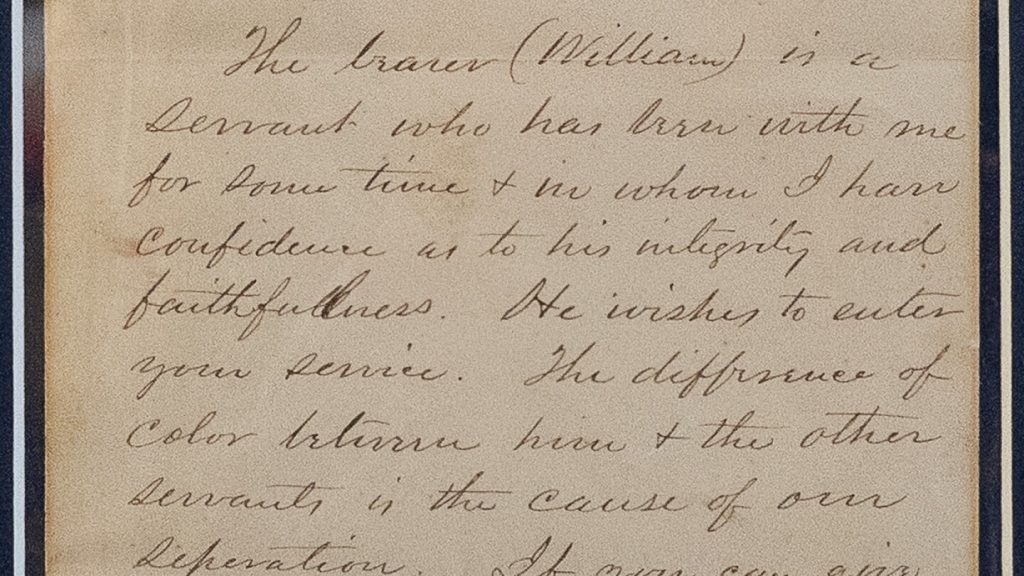Listen to the article
A rare handwritten letter from Abraham Lincoln has been donated to the Abraham Lincoln Presidential Library and Museum, offering a remarkable glimpse into the 16th president’s relationship with a Black employee during the tumultuous early days of his presidency.
The letter, penned on March 16, 1861, just weeks after Lincoln’s inauguration, was written on behalf of William Johnson, a 28-year-old Black man who had served as Lincoln’s valet and driver in Springfield since 1859. In the note addressed to Navy Secretary Gideon Welles, Lincoln sought employment for Johnson, who was being ostracized by lighter-skinned Black White House staff members.
“The difference of color between him and the other servants is the cause of our separation,” Lincoln explained in the brief but revealing message. Welles reportedly responded that he had no position available at the time.
The document, donated by private collector Peter Tuite in August, is now on public display at the presidential library and museum in Springfield, Illinois.
Christina Shutt, executive director of the library and museum, noted the letter’s multilayered significance. “We see him trying to help a friend. We see that even the new president cannot casually hand out jobs,” Shutt said. “We see issues of class and color within the White House.”
What makes the letter particularly extraordinary is its timing. Lincoln wrote it barely two weeks after taking office, as the nation stood on the precipice of Civil War with Southern states already seceding from the Union. That the newly inaugurated president would take time during this national crisis to advocate for a Black employee highlights a personal dimension of Lincoln rarely seen in official historical records.
James Conroy, a historian and author who has written extensively about Lincoln’s White House, told The Associated Press that this personal intervention aligns with Lincoln’s general treatment of staff. “Nobody can question that Lincoln was a very kindly guy, very empathetic, trying to help people when he could,” Conroy said. “And that crossed Black and white and male and female and everything else. He was a genuinely good guy.”
According to historical accounts, Lincoln treated the White House staff—largely composed of freed African Americans—with unusual respect for the era. He reportedly never demanded service but asked politely and tried to ease their burdens when possible.
The letter also provides insight into the complex racial dynamics within the White House itself. Johnson’s rejection by other Black staff members due to his darker complexion reveals the nuanced hierarchies and colorism that existed even among freed Black Americans in the Civil War era.
Lincoln eventually secured a position for Johnson at the Treasury Department in November 1861. Their working relationship continued, with Johnson shaving the president daily and frequently serving as his chauffeur.
The relationship between the two men extended beyond employer and employee. Johnson accompanied Lincoln to Pennsylvania in November 1863 for the delivery of the Gettysburg Address. During this trip, Johnson nursed Lincoln when he exhibited symptoms of a mild case of smallpox. Tragically, Johnson himself contracted the disease—possibly from Lincoln or during one of several Washington outbreaks—and died in early 1864.
Lincoln’s concern for Johnson continued even during the man’s illness. Historical records show the president personally collected Johnson’s paycheck and ensured it reached him while he was sick. After Johnson’s death, Lincoln paid for his coffin and offered to pay off a $150 loan in Johnson’s name, though the bank ultimately forgave half the debt.
The newly displayed letter provides a rare window into Lincoln’s personal character and his complex relationship with race during a pivotal moment in American history—a small but significant artifact that enhances our understanding of both the man and his era.
Fact Checker
Verify the accuracy of this article using The Disinformation Commission analysis and real-time sources.




10 Comments
Fascinating to see Lincoln advocating for his Black friend and employee during such a tumultuous time. It speaks to his strong personal relationships and commitment to equal opportunity, even in the face of societal prejudices.
The letter provides an intimate look into Lincoln’s character and the challenges faced by Black individuals in that era. It’s heartening to see the president using his influence to support a friend and colleague.
This letter provides a rare glimpse into the personal side of a revered historical figure. Lincoln’s willingness to advocate for his friend, despite societal prejudices, speaks to his character and principles.
The donation of this letter to the presidential museum is a valuable contribution to the historical record. It allows us to better understand Lincoln’s relationships and the challenges faced by Black individuals in that era.
It’s heartening to see Lincoln using his influence to support a friend and colleague. This letter offers a unique perspective on the president’s personal relationships and commitment to fairness.
The museum’s display of this letter is an important opportunity to educate the public about the experiences of Black Americans during Lincoln’s presidency. It’s a valuable addition to the historical narrative.
I’m curious to learn more about William Johnson and his relationship with Lincoln. The president’s efforts to find him employment despite social barriers are admirable and reveal an important aspect of his legacy.
It would be interesting to research how Johnson’s story unfolded after this letter was written. The museum’s display of this document is a chance to shed light on the experiences of Black Americans during Lincoln’s time.
This letter is a powerful historical artifact, showcasing Lincoln’s personal dedication to fairness and inclusion. It’s remarkable that such a personal request from the president has survived to this day.
The donation of this letter to the presidential museum is a wonderful opportunity for the public to gain insight into Lincoln’s values and relationships. It’s a valuable addition to the historical record.